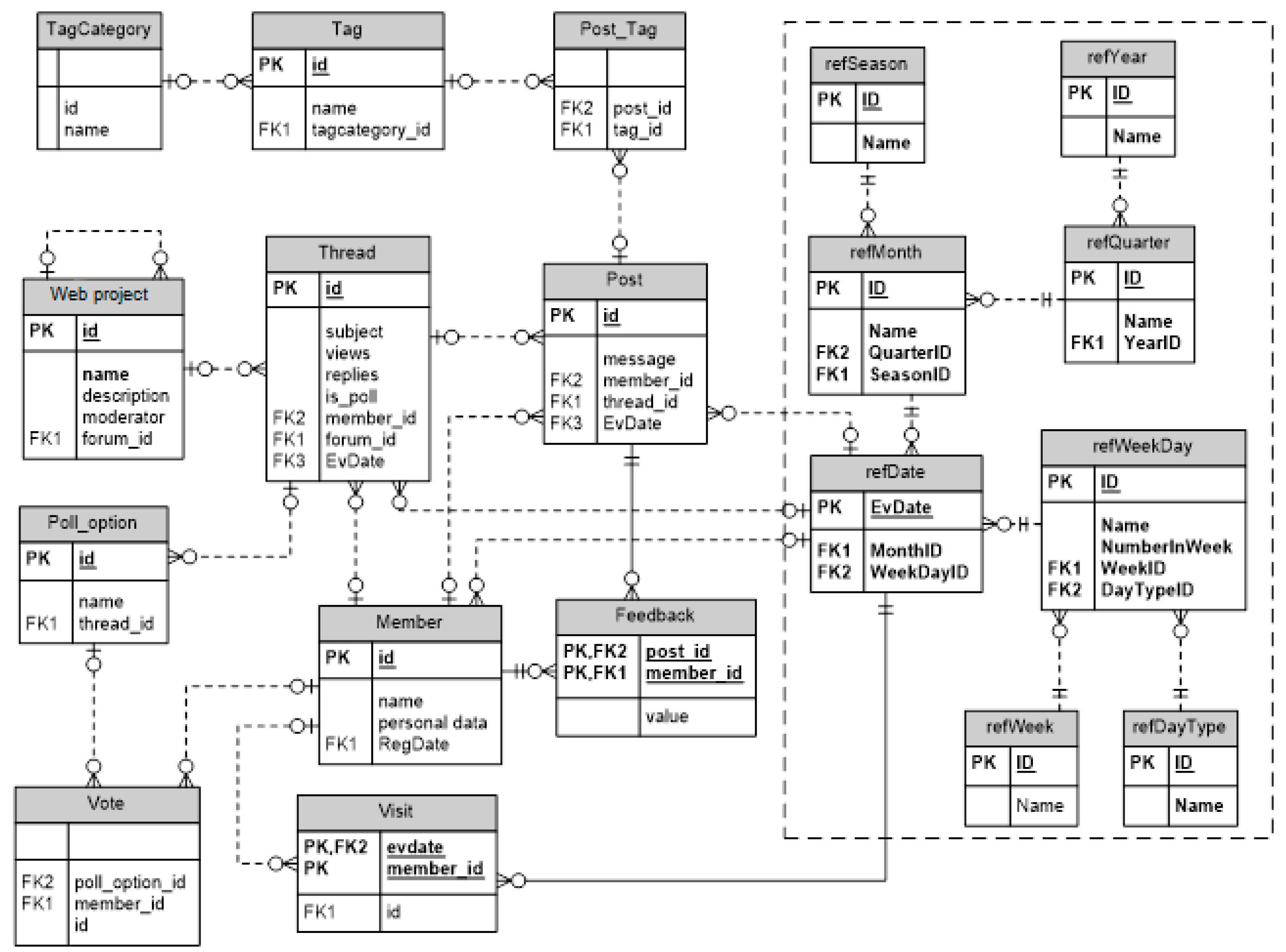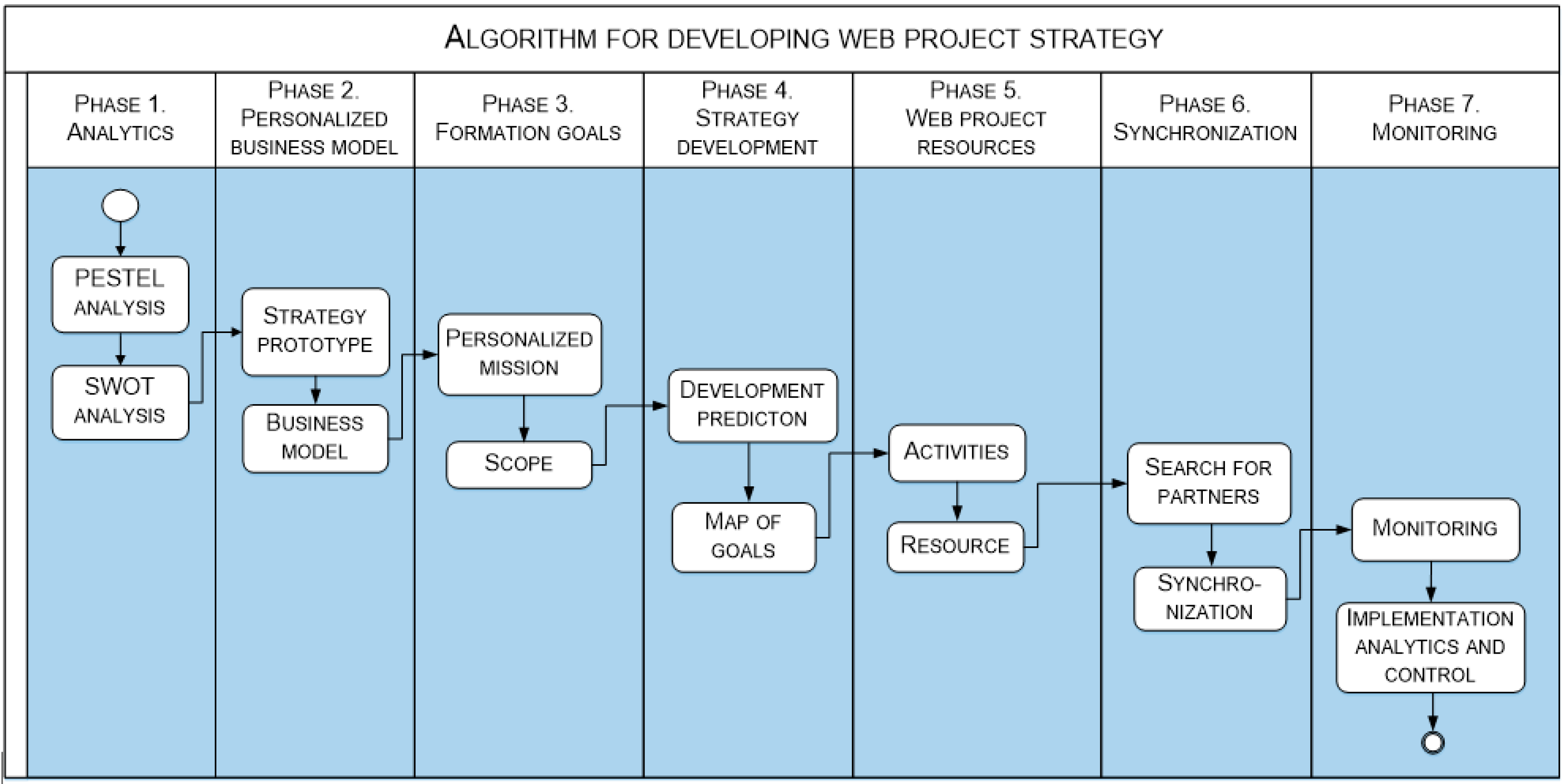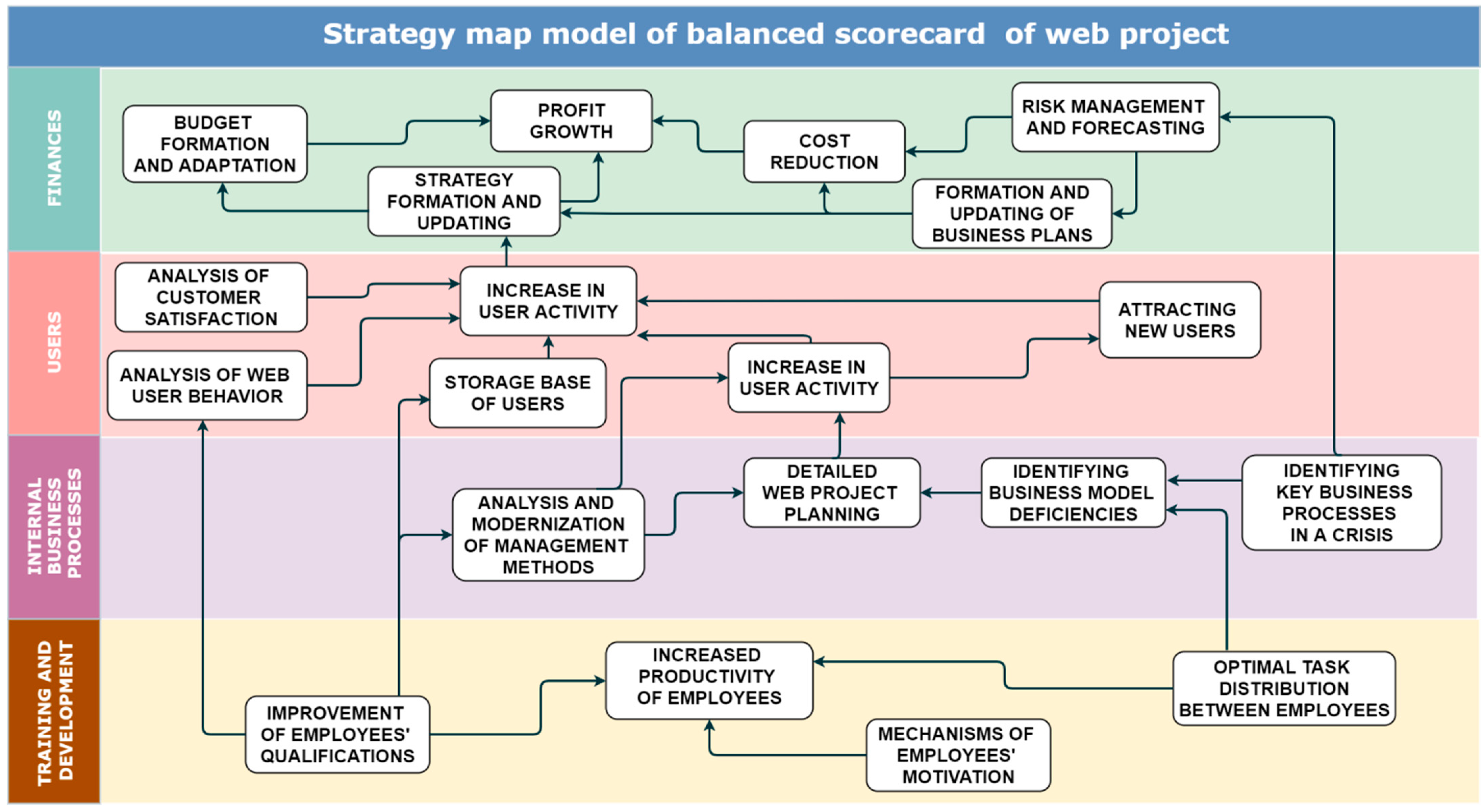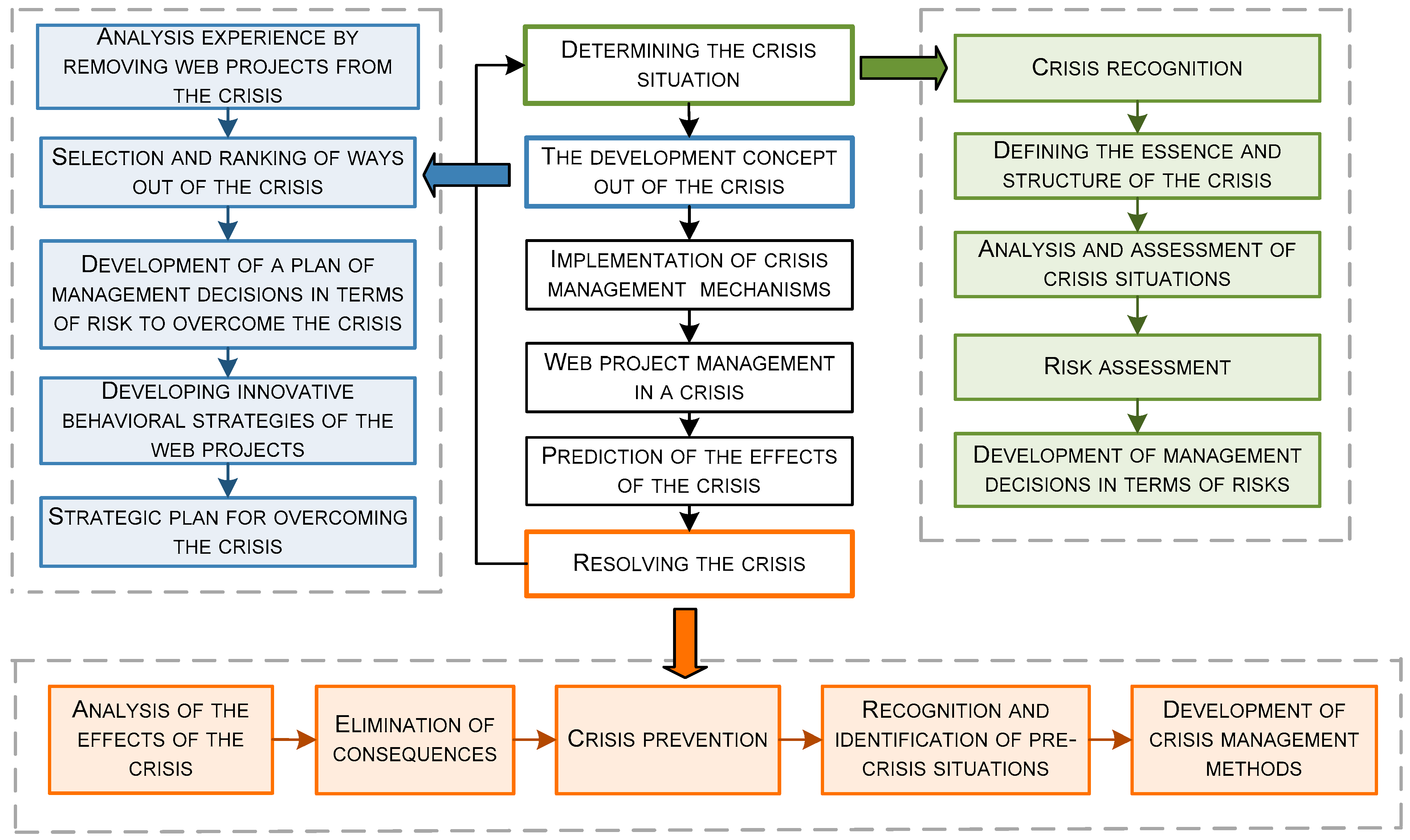Development of Methods for the Strategic Management of Web Projects
Abstract
1. Introduction
2. Materials and Methods
2.1. Analysis and Modelling of the Structure of a Web Project
- guests—who view the web project content available to them;
- participants—who actively participate in the web project, creating text content, posting photo and video content, posts, topics, and pages;
- moderators—who have the ability to manage the project on the first level and all access rights belonging to the web project participants;
- administrators—who act as web project managers with all available access rights to manage the web project.
- profit—the most important priority would be attendance, because there is a direct correlation between “attendance” and “profit”;
- authority in the community—citation rate and number of participants will be significant;
- information and technical customer support—the quality and volume of information content is the most important priority;
- attracting audiences to related web projects—the top priorities will be attendance and number of participants.
2.2. Methods for Designing and Implementing a Web Project Development Strategy
- balance—management of the web project in accordance with the concept of a balanced strategic management of all areas of company functioning, i.e., implementation of the planned indicators on the basis of the developed strategy;
- competitiveness—examination of the weaknesses of web projects management of the competitors and establishing a competitive advantage over competitor web projects through the implementation of an effective strategy;
- efficiency—strategic management of the web community in compliance with the objectives of the set strategy contributes to a prolonged increase in the performance of the web project in the long term according to the results of the implemented strategy changes achieved by the implementation of previous strategic decisions;
- quality—the clear and precise formulation of strategic goals of the web project for the successful functioning of the community, consistency of the strategic goals and overall strategy with trends and requirements of the web environment projects, resistance to change, flexibility, objectivity and compliance with the web project capacities and control over it;
- responsiveness—the responsiveness of the developed strategy to the web project’s internal and external environment to achieve the intended results, taking into account the web project’s strengths and weaknesses, the web project’s opportunities, threats to the web project, and the specifics of the web space sector;
- scope—capturing key aspects of the web project’s functionality, internal consistency of the components, the level of risk, and the flexibility of the strategy.
2.3. Strategic Planning of Web Project Development for Its Effective Functioning
- PESTEL analysis. A structured analysis of external factors and their impact on the development of the web project.
- SWOT analysis. Analysis of the strengths and weaknesses of the web project.
- 3.
- Prototype strategy. Initial strategic ideas based on a personalized SWOT analysis.
- 4.
- Business model. Visualization of the personalized business model and the cost and profit model.
- 5.
- Establishing a mission statement. Formation of the personalized mission of the web project and its designation.
- 6.
- Areas of activity. Establishment of a function for the implementation of the web project’s personalized objectives.
- 7.
- Predicting development. Predicting the development and status of the web project in 5–10 years.
- 8.
- A map of goals. Development of a logical framework for achieving the set personalized objectives in the development of the web project and the formation of a personalized strategy map of the web project.
- 9.
- Activities. Planning personalized strategic actions to achieve the objectives.
- 10.
- Resources. Planning the resources needed to implement the strategic projects.
- 11.
- Partner Search. This process is carried out to find partners for the implementation of a personalized web project strategy.
- 12.
- Synchronization. The process of synchronization with interested representatives of potential partners.
- 13.
- Monitoring. Continuous monitoring of the implementation of the strategic objectives of the web projects and, if necessary, updating the strategy in order to update objectives.
- 14.
- Analyzing the implementation of the strategy and monitoring. Evaluation and control of the strategy implementation.
2.4. Assessments of the Web Project Environment in a Strategic and Structured Way Using PESTEL Analysis
2.5. Modelling a Strategic Map for a Balanced Scorecard of a Web Project
- Setting strategic goals;
- SWOT analysis and identification of success factors;
- Definition of indicators and its target values;
- Determining how to calculate the indicators;
- Causal chains of strategic goals;
- Cascading strategic goals;
- Strategic action plan;
- Maintain, update, and develop the balanced scorecard (BSC).
2.6. Model Web Project Scenario in a Situation
- Active scenario of web project development: the goal is to create a stable project without overly active spoilers. Priority is the stability of the web project and the quality of its content, rather than popularity.
- A hyperactive scenario of web project development: the goal of a hyperactive web project is to achieve high popularity by attracting as many active participants as possible.
- Reactive scenario of web project development: this scenario is chosen when the goal of creating a web project is to obtain feedback from the participants to observe how the community reacts to a particular event. Typically, this development scenario is chosen by news project owners.
- Cumulative development of a web project: this development scenario is chosen when the goal is to accumulate quality information in a particular field. Such information is accumulated through the involvement of experts in the field, who will fill the web project with rich and informative messages. Emphasis is placed on the quality and thoroughness of the content, not on the quantity or frequency of updates.
3. Results and Discussion
- Scientific Cluster “IntelliGo” (Insta)—in November 2019, the web project managers began to implement a development strategy. The project was in crisis in April, but successfully emerged from this crisis situation and continues to adhere to the strategy.
- The Language Learning Centre (Fb)—web project that has been operating since 2016. In May 2019, it hit a crisis period that lasted for seven months. The management developed a strategic plan to overcome the crisis and introduced appropriate management solutions.
- SKID-Press (Fb)—web project managers have not implemented development strategies; therefore, the web project is unsuccessful with low performance.
- Department SKID (Fb)—managers were successfully implementing the developed strategy until January 2019, but since December 2020 the performance of this project has been steadily declining.
- Lviv Polytechnic Institute of Humanities and Social Sciences (Fb) and IntelliGo-Science Cluster (Fb)—in October 2019, the leaders of these web projects started to implement development strategies. Their performance indicators are increasing.
4. Conclusions
Author Contributions
Funding
Institutional Review Board Statement
Informed Consent Statement
Data Availability Statement
Conflicts of Interest
References
- Ivanova, A.S.; Holionko, N.G.; Tverdushka, T.B.; Olejarz, T.; Yakymchuk, A.Y. The Strategic Management in Terms of an Enterprise’s Technological Development. J. Compet. 2019, 11, 40. [Google Scholar] [CrossRef]
- Byun, J.; Sung, T.E.; Park, H.W. Technological innovation strategy: How do technology life cycles change by technological area. Technol. Anal. Strateg. Manag. 2018, 30, 98–112. [Google Scholar] [CrossRef]
- Rodriguez-Bolivar, M.P.; Alcaide-Muñoz, C.; Alcaide-Muñoz, L. Characterising smart initiatives’ planning in Smart Cities: An empirical analysis in Spanish Smart Cities. In Proceedings of the 13th International Conference on Theory and Practice of Electronic Governance, Athens, Greece, 23–25 September 2020; pp. 585–595. [Google Scholar] [CrossRef]
- Hussain, S.; Khattak, J.; Rizwan, A.; Latif, M.A. ANSOFF matrix, environment, and growth-an interactive triangle. Manag. Adm. Sci. Rev. 2013, 2, 196–206. [Google Scholar]
- Derbyshire, J.; Wright, G. Augmenting the intuitive logics scenario planning method for a more comprehensive analysis of causation. Int. J. Forecast. 2017, 33, 254–266. [Google Scholar] [CrossRef]
- Al Shobaki, M.J.; Abu Naser, S.S. Decision support systems and its role in developing the universities strategic management: Islamic university in Gaza as a case study. Int. J. Adv. Res. Dev. 2016, 1, 33–47. [Google Scholar]
- Wu, T.; Naidoo, V. The Role of International Marketing in Higher Education; Palgrave Macmillan: New York, NY, USA, 2016; pp. 3–9. [Google Scholar] [CrossRef]
- Al Shobaki, M.J.; Abu Amuna, Y.M.; Abu-Naser, S.S. The impact of top management support for strategic planning on crisis management: Case study on UNRWAGaza Strip. Int. J. Acad. Res. Dev. 2016, 1, 20–25. [Google Scholar]
- Alekseyeva, K. Development of the decision support system for choosing Web project management strategy under conditions of uncertainty. Development 2015, 2, 203–214. [Google Scholar]
- Alekseyeva, K. Method of choosing Web project management strategy with using of modified analytic hierarchy process. J. Multidiscip. Eng. Sci. Technol. 2015, 2, 1946–1953. [Google Scholar]
- Morris, P.W.; Jamieson, A. Moving from corporate strategy to project strategy. Proj. Manag. J. 2005, 36, 5–18. [Google Scholar] [CrossRef]
- Druckman, J.N.; Kifer, M.J.; Parkin, M. Timeless strategy meets new medium: Going negative on congressional campaign Web sites, 2002–2006. Political Commun. 2010, 27, 88–103. [Google Scholar] [CrossRef]
- Mendes, E.; Mosley, N.; Counsell, S. The application of case-based reasoning to early Web project cost estimation. In Proceedings of the 26th Annual International Computer Software and Applications, Oxford, UK, 26–29 August 2002; pp. 393–398. [Google Scholar] [CrossRef]
- Aoyama, M. Web-based agile software development. IEEE Softw. 1998, 15, 56–65. [Google Scholar] [CrossRef]
- Fedushko, S.; Ustyianovych, T.; Gregus, M. Real-time high-load infrastructure transaction status output prediction using operational intelligence and big data technologies. Electronics 2020, 9, 668. Available online: https://www.mdpi.com/2079-9292/9/4/668 (accessed on 20 April 2020). [CrossRef]
- Izonin, I.; Tkachenko, R.; Kryvinska, N.; Zub, K.; Mishchuk, O.; Lisovych, T. Recovery of Incomplete IoT Sensed Data using High-Performance Extended-Input Neural-Like Structure. Procedia Comput. Sci. 2019, 160, 521–526. [Google Scholar] [CrossRef]
- Izonin, I.; Kryvinska, N.; Vitynskyi, P.; Tkachenko, R.; Zub, K. GRNN Approach Towards Missing Data Recovery Between IoT Systems. In Advances in Intelligent Networking and Collaborative Systems; Springer: Cham, Switzerland, 2020; pp. 445–453. [Google Scholar]
- Beshley, M.; Kryvinska, N.; Seliuchenko, M.; Beshley, H.; Shakshuki, E.M.; Yasar, A. End-to-End QoS “Smart Queue” Management Algorithms and Traffic Prioritization Mechanisms for Narrow-Band Internet of Things Services in 4G/5G Networks. Sensors 2020, 20, 2324. [Google Scholar] [CrossRef] [PubMed]
- Poniszewska-Maranda, A.; Matusiak, R.; Kryvinska, N.; Yasar, A.-U.-H. A real-time service system in the cloud. J. Ambient Intell. Humaniz. Comput. 2020, 11, 961–977. [Google Scholar] [CrossRef]
- Kryvinska, N.; Bickel, L. Scenario-Based analysis of IT enterprises servitization as a part of digital transformation of modern economy. Appl. Sci. 2020, 10, 1076. [Google Scholar] [CrossRef]
- Markovets, O.; Pazderska, R.; Horpyniuk, O.; Syerov, Y. Informational support of effective work of the community manager with web communities. CEUR Workshop Proc. 2020, 2654, 710–722. [Google Scholar]
- Havierniková, K.; Lemańska-Majdzik, A.; Mura, L. Advantages and Disadvantages of the Participation of SMEs in Tourism Clusters. J. Environ. Manag. Tour. 2017, 8, 1205–1215. [Google Scholar]
- Korauš, A.; Kaščáková, Z.; Felcan, M. The impact of ability-enhancing HRM practices on perceived individual performance in IT industry in Slovakia. Cent. Eur. J. Labour Law Pers. Manag. 2020, 3, 33–45. [Google Scholar] [CrossRef]
- Anyakoha, C. Job analysis as a tool for improved organizational performance of SMEs in Lagos, Nigeria. Cent. Eur. J. Labour Law Pers. Manag. 2019, 2, 7–16. [Google Scholar] [CrossRef]
- Tomčík, M.; Rosenlacher, P. Number of advertisements per day and their relevance to consumers. Acta Oeconomica Univ. Selye 2018, 7, 162–174. [Google Scholar]
- Mura, L.; Sleziak, J. Innovation and Entrepreneurship Network. In Proceedings of the CERS 2014: 5th Central European Conference in Regional Science, International Conference Proceedings, Košice, Slovakia, 5–8 October 2015; pp. 643–651, ISBN 978-80-553-2015-1. [Google Scholar]
- Svec, M.; Olsovska, A.; Mura, L. Protection of an “Average Consumer” in the Digital Society—European Context. International Scientific Conference on Marketing Identity. In Marketing Identity: Digital Life, Pt II. Book Series: Marketing Identity; Faculty of Mass Media Communication: Trnava, Slovakia, 2015; pp. 273–282. ISBN 978-80-8105-780-9. [Google Scholar]
- Milošević, I.; Rajić, T.; Voza, D.; Nikolić, Đ.; Mihajlović, I. Strategic analysis of commitment in the relationships between customers and suppliers. Acta Oeconomica Univ. Selye 2015, 4, 118–127. [Google Scholar]











| External Factors | Opportunities | Threats |
|---|---|---|
| Political factors |
|
|
| Economic factors |
|
|
| Social-cultural factors |
|
|
| Technological factors |
|
|
| Eco-factors |
|
|
| Legal factors |
|
|
Publisher’s Note: MDPI stays neutral with regard to jurisdictional claims in published maps and institutional affiliations. |
© 2021 by the authors. Licensee MDPI, Basel, Switzerland. This article is an open access article distributed under the terms and conditions of the Creative Commons Attribution (CC BY) license (http://creativecommons.org/licenses/by/4.0/).
Share and Cite
Fedushko, S.; Peráček, T.; Syerov, Y.; Trach, O. Development of Methods for the Strategic Management of Web Projects. Sustainability 2021, 13, 742. https://doi.org/10.3390/su13020742
Fedushko S, Peráček T, Syerov Y, Trach O. Development of Methods for the Strategic Management of Web Projects. Sustainability. 2021; 13(2):742. https://doi.org/10.3390/su13020742
Chicago/Turabian StyleFedushko, Solomiia, Tomáš Peráček, Yuriy Syerov, and Olha Trach. 2021. "Development of Methods for the Strategic Management of Web Projects" Sustainability 13, no. 2: 742. https://doi.org/10.3390/su13020742
APA StyleFedushko, S., Peráček, T., Syerov, Y., & Trach, O. (2021). Development of Methods for the Strategic Management of Web Projects. Sustainability, 13(2), 742. https://doi.org/10.3390/su13020742








